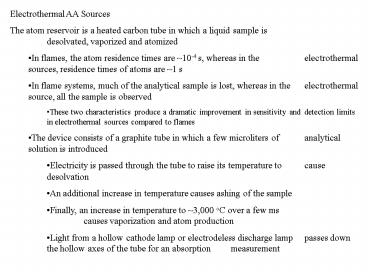Electrothermal AA Sources - PowerPoint PPT Presentation
1 / 6
Title:
Electrothermal AA Sources
Description:
In flames, the atom residence times are ~10-4 s, whereas in the electrothermal ... In flame systems, much of the analytical sample is lost, whereas in the ... – PowerPoint PPT presentation
Number of Views:214
Avg rating:3.0/5.0
Title: Electrothermal AA Sources
1
- Electrothermal AA Sources
- The atom reservoir is a heated carbon tube in
which a liquid sample is desolvated, vaporized
and atomized - In flames, the atom residence times are 10-4 s,
whereas in the electrothermal sources,
residence times of atoms are 1 s - In flame systems, much of the analytical sample
is lost, whereas in the electrothermal source,
all the sample is observed - These two characteristics produce a dramatic
improvement in sensitivity and detection limits
in electrothermal sources compared to flames - The device consists of a graphite tube in which a
few microliters of analytical solution is
introduced - Electricity is passed through the tube to raise
its temperature to cause desolvation - An additional increase in temperature causes
ashing of the sample - Finally, an increase in temperature to 3,000 oC
over a few ms causes vaporization and atom
production - Light from a hollow cathode lamp or electrodeless
discharge lamp passes down the hollow axes of
the tube for an absorption measurement
2
- Electrothermal AA Sources
- Instrument designs - see Figures in SHN
- The designs incorporate one or two inert gas flow
systems - An external inert gas flow covers the outside of
the graphite tube to prevent its incineration - Some atomizers pass inert gas through the ends of
the tube out the central port to carry away
vapors produced during desolvation and ashing - The introduction of the Lvov platform gives
higher reproducibility - This is a flat carbon plate inserted into the
tube - Atomization is delayed because the sample is not
in direct contact with the carbon tube - The temperature is not changing rapidly during
the atomization step - The graphite tube is porous and to prevent
absorption of analyte in the graphite and
carryover from sample to sample, tubes are
layered with pyrolytic carbon - Pass a mixture of methane and inert gas through
the tube while it is held at a constant, high
temperature - Absolute detection limits 10-13-10-10 g of
analyte on 0.5-10 mL of sample
3
- Electrothermal AA Sources
- Background correction is necessary when using
electrothermal atomizers because a great deal
of smoke is produced during the vaporization
and atomization process - The smoke introduces large spectral interferences
that must be taken into account - The usual way of background correction is the use
of an auxiliary continuum source - Light from the atomic source and continuum
sources through the atomizer is alternated
either mechanically of electrically - The difference in radiant power from the
alternating sources passing through the flame
is electronically subtracted to give absorbance
due only to the analyte atoms
4
- Inductively Coupled Argon Plasma AE Sources
- A plasma is an electricically conducting gas
atoms are ionized to cations and electrons - The ICAP consists of three concentric quartz
tubes and a water cooled Cu induction coil
through which Ar flows at a total flow rate of - 11-17 L/min
- Cooling Ar is passes tangentially through the
anular space between the outer most and next
outer most tubes - Ar that produces the plasma is passed in laminar
flow through the annular space between the
innermost and next outer tubes - Ar carrying sample aerosol is passed through the
innermost tube - The induction coil is connected to a 2 kW 27 mHz
RF power supply - A Tesla coil produced spark produces sufficient
ions to create a self sustaining plasma when RF
power is applied - The ions and electrons move in a circular path in
the oscillating RF magnetic field - Heating is produced due to Ohmic resistance to
charge transport
5
- Inductively Coupled Argon Plasma AE Sources
- Sample introduction
- Most samples are in the form of aqueous solutions
and are introduced by a nebulizer system similar
to that used in flame systems - Ultrasonic nebulizers are also available for
liquids and solids - Samples can also be introduced by deposition on a
Ta strip and evaporated into an Ar stream by
electrical heating - Plasma appearance and spectra
- The plasma consists of a brilliant, white opaque
region within the volume of the induction coil
extending 2 mm above its top - This region consists of a continuum spectrum
superimposed on the line spectrum of Ar - Between 10-30 mm above the brilliant core is an
optically transparent, continuum free region
with little emission from Ar - Analytical observations are made in the region
15-20 mm above the core - Some elements are in ionized form in this region
(Ca, Ca2, Cd, Cr2, Mn2) - Atomization and Ionization
- Before reaching the observation point, atoms will
have been at 6,000 K- 8,000 K for 2 ms each 2-3
x that for a flame - Vaporization and atomization much more complete
than in flames resulting in less interference - Ionization interference tends to be small because
of high e- concentration
6
- Inductively Coupled Argon Plasma AE Sources
- Atomization and Ionization
- Atomization takes place in an inert environment
preventing oxide formation - Self absorption is reduced because the
temperature profile is very constant across the
volume of the plasma - Calibration curves - see Figure in SHN
- Detection limits and sensitivities - see table in
SHN and handouts - Instrumentation
- Simultaneous instruments based on Rowland circle
- Sequential instruments based on Czerny-Turner
mounts































